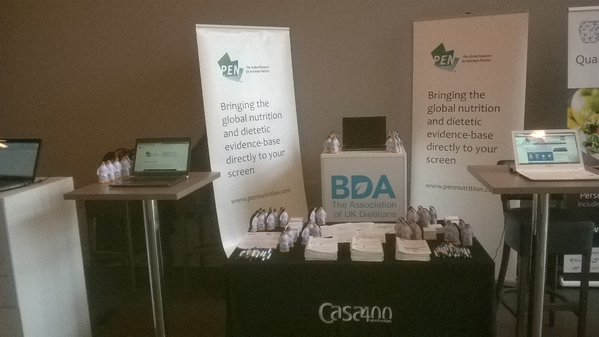PEN eNews 5(3) November 2015
PEN
® eNews is a monthly e-newsletter shared with the global PEN Community and created to help dietitians position themselves as leaders in evidence-based nutrition practice. In addition, users of the PEN System will find articles on the new evidence, resources and features available and how to maximize one's use of PEN.

infographics: a picture may be worth a 1000 words
I am noticing an increasing number of infographics around health, food and nutrition online. Infographics are a way of communicating complex information into a palatable, easily consumable format through the use of images with little text (1-4). With information availability being akin to drinking from a fire hose, infographics may be a welcome change to sharing complex information. They are attention-grabbing, visual and easily shareable, and thus may offer some advantages over communicating the same information via text (4,5). A picture may just be worth a 1000 (or more) words.
| Examples of infographics that have caught my attention:
|
Infographics and other forms of data visualization are part of the fields of health communications, epidemiology, public health (2,3) and knowledge translation (4). Research is underway to examine best practices, potential usefulness and impact of data visualization (2,4).
PEN® knowledge database infographic.
Nybro and Skolnik (2) note that it is critical to identify the story being told in data visualization and to understand the target audience, but that we must first understand our data. This latter part caught my attention. As with any resource, there is the potential for infographic misuse. Information can be misused, misrepresented or biased to suit a specific purpose or agenda. It is important to be able to reference the various parts of an infographic (1). I would add that it is important to consider the overall synthesis of data for the area of interest so as to not bias your infographic presentation with data that does not consider the overall body of evidence.
The quality of an infographic is only as good as the source of information on which it is based.
Interested to learn more about infographic creation? This
presentation from Ontario Public Health outlines preparatory work to be done prior to creating an infographic and kinds of infographics to create (3). This
site from the Health Science Information Consortium of Toronto (1) lists infographic resources to get you started. If you have created an infographic, I’d love to see it!
Email me a link, a jpeg image or a pdf file to enews@pennutrition.com
In this issue of PEN
® eNews 5(3), we have articles sharing some exciting new developments in the PEN
® knowledge database.
- Using GRADE to grade the evidence in PEN® outlines a system of grading research and our plans for incorporating GRADE.
- How do I…find timely information on hot topics on nutrition in PEN®? Will help you find the latest evidence-based responses to nutrition-related topics in the news.
- Insights into dietetics in the Land of Fire and Ice while on my summer vacation offers an insider’s look into dietetic practice in Iceland.
- International working party tackles the important and high-risk area of food allergy to update and expand the practice guidance in PEN® provides an update on practice guidance in the area of food allergy.
- What does an iceberg have to do with eating? Incorporating the cognitive-behavioural approach in your practice outlines an area of practice opportunity for dietitians.
- PENny the PENguin: Her story describes how the PEN® mascot came to become an international traveling sensation!
This and more in PEN eNews 5(3).
Kristyn Hall MSc,
RD Editor,
PEN® eNewsReferences:
- Health Science Information Consortium of Toronto. Infographics. June 2, 2015. Available from: http://guides.hsict.library.utoronto.ca/content.php?pid=568839&sid=4690381#17272500
- Nybro E, Skolnik L. Data Visualization: A Tool for health communicators. October 2013. Available from: https://www.k4health.org/blog/post/data-visualization-tool-health-communicators
- Rosa S. Infographic development. Public Health Ontario. 2015. Available from: https://www.publichealthontario.ca/en/LearningAndDevelopment/Events/Pages/Infographics.aspx
- Crick K, Hartling L. Preferences of knowledge users for two formats of summarizing results from systematic reviews: infographics and critical appraisals. 2015 Oct 14. Available from: http://www.ncbi.nlm.nih.gov/pmc/articles/PMC4605679/
- Milovanovic D, Ivanisevic L. Infographic as a marketing communication tool. Symorg 2014. Available from: http://symorg.fon.bg.ac.rs/proceedings/papers/04%20-%20COMMUNICATION%20MANAGEMENT%20AND%20SOCIAL%20NETWORKING%20.pdf#page=23
PEN
®
eNews may contain links to other external websites.
PENnutrition.com is not
responsible for the privacy practices or the content of such external websites.
Neither Dietitians of Canada, nor any dietetic associations contributing to or
licensing the content in Practice-based Evidence in Nutrition:
PEN
® endorse the content, products or services
on other websites.
What's New in PEN®
Below is a quick glance at some of the new and updated content in the PEN
® knowledge database. Look for the new

and updated

symbols in PEN to see more new and enhanced content!
New Knowledge Pathways
New Practice Questions
Professional Tools
Trending Topics
Client Tools
Updated Knowledge Pathways
Updated Practice Questions
How Do I … find timely information in PEN® on trending nutrition-related topics?
Written by Jane Bellman MEd, RD
Kerri Staden BSc, RD Dietitians of Canada
PEN® Resource Managers
Do you want to access the latest evidence-based responses to nutrition-related topics in the news? Visit Trending Topics in the PEN® knowledge database! This past June, the ‘News-making Evidence’ section was renamed Trending Topics. This new name, Trending Topics, provides a more accurate description of the type of content you will find within this section of PEN. Our aim with Trending Topics is to help provide credible and evidence-based responses to “hot topics” in the news.
Dietitians from around the world receive questions about nutrition from consumers, clients, other health professionals and the media. As busy practitioners, it can be very challenging to keep up with knowing what is in the news and what is credible. To help you, we regularly scan the media for nutrition-related topics and posts, such as:
Visit
Trending Topics regularly for the latest evidence-based responses to nutrition-related topics. Want Trending Topics to come to you? Sign up for a monthly notification via PEN
Content Alerts. We also share newly posted Trending Topics via our social media channels. You can follow us on
Twitter, like us on
Facebook and connect with us on
LinkedIn.
Submitted by
Jayne Thirsk* RD, PhD, FDC
Director PEN®: Practice-based Evidence in Nutrition®
Dietitians of Canada
Using GRADE to grade the evidence in
PEN®
knowledge database
Read any good clinical practice guidelines lately? If you have, you may have noticed that they have used the GRADE system to find and evaluate the evidence and to make recommendations regarding health related issues.
Grading research allows the user to quickly draw conclusions about the quality of the evidence and use this information to guide their practice decisions.
GRADE is an acronym for:
Grading of
Recommendations
Assessment
Development
Evaluation and it has been endorsed or is
being adopted by guideline groups, organizations etc. all over the world. The GRADE approach is guided by leaders in evidence-based medicine with a desire to create a common evidence grading system that is credible, reproducible and understandable by guideline users everywhere.
Early in September, the PEN
® GRADE working group met in Toronto, Ontario to begin intensive training to transform how the evidence is graded to make practice recommendations for the PEN database. PEN will join over 75 prestigious organisations such as the WHO, the Cochrane Collaboration, National Institute of Clinical Excellence (NICE) in using the GRADE system.
We were fortunate to receive our education from Dr Nancy Santesso (RD, MLIS, PhD) from the McMaster GRADE training centre. Over 4 full days we learned about the GRADE techniques and began to develop what will be the PEN GRADE process. The fact that she began her career as a dietitian meant that she was able to provide illustrative examples to us in “dietetic language” using nutrition evidence examples.
GRADE guidelines are transparent in terms of the processes used to find and evaluate the evidence and they focus on outcomes.
GRADE recommends standards for how to:
- identify the practice questions and outcomes of interest
- use evidence that has been systematically gathered and synthesized
- assess and summarize the evidence for each outcome
- summarize and use the evidence for other factors important to decision making (patient values and preferences, resources, acceptability, equity, feasibility etc.)
- make a recommendation noting the strength of the recommendation and the quality of evidence upon which it is based.
Here is an excerpt from a recent guideline (1) prepared using the GRADE approach:
Recommendations for preventing fracture in long-term care.
“For residents at high risk of fractures who cannot meet the recommended dietary allowance for calcium through dietary intake, we recommend daily supplements of calcium up to 500 mg.”
Strong recommendation; Moderate-quality evidence
Remarks
“The recommendation for residents at high risk places a high value on the reduction in hip fractures and the small reductions in vertebral and non-vertebral fractures and in mortality that can be achieved with calcium supplementation. It places a lower value on the small increased risk of gastrointestinal adverse effects that may occur and the resources required in long-term care to provide calcium supplementation.”
“These recommendations apply to supplementation with any calcium compound, including calcium carbonate or citrate. The recommendation to limit supplementation to 500 mg was based on the uncertainty about harms of calcium supplementation in studies of community-dwelling individuals who received calcium supplementation of 1000 mg or more daily. The benefits of calcium supplementation are closely linked to adequate vitamin D intake.”(1)
1. Papaioannou A, Santesso N, Morin S, Feldman S, Adachi J, Crilly R et al. Recommendations for preventing fracture in long-term care. CMAJ. 2015 Sept 14.
http://www.ncbi.nlm.nih.gov/pubmed/26370055 OR
http://www.cmaj.ca/content/early/2015/09/14/cmaj.141331
Transitioning PEN to using GRADE
Using GRADE will make the key practice points in PEN easier to interpret and quicker to read. PEN has always given dietitians an assessment of the strength of the evidence, moving to a system that is widely recognized by other health professionals will make it easier for dietitians to communicate benefits of treatment to the wider multi-disciplinary team.
Many of our
current PEN processes are in line with the GRADE approach while others will need to be enhanced or made more explicit. GRADE does not simply focus on RCT data, rather it encourages incorporation of many types of studies and information related to patient preferences, equity, feasibility etc. to inform decisions. PEN is a respected source of information for dietitians around the world, gradually incorporating GRADE into PEN’s systems and processes will enable it to maintain and strengthen its influence.
The PEN international collaboration is about more than simply synthesizing the evidence for busy dietetic practitioners. A key objective of the collaborative partnership is to build capacity for dietitians to be not only knowledgeable users of evidence but also skilled contributors to the creation of evidence-based practice recommendations. The PEN team will work closely with the MacGRADE training centre at McMaster University to create a series of short videos/modules to help dietitians understand and use GRADE … whether they are looking at PEN
® evidence or guidelines created by other authoritative sources.
Leaders share their enthusiasm for transitioning PEN® to using GRADE:
“The PEN Collaboration is committed to providing-practice based evidence in nutrition, and now to incorporating GRADE. I’m sure it is why PEN has been and will continue to be an invaluable resource to dietitians!” Dr Nancy Santesso, MacGRADE training Centre
“Using GRADE will help dietitians to present evidence for their practice in a way that is understood by colleagues across the world.” Dr Judy Lawrence, BDA
“Using an internationally recognised system such as GRADE to evaluate the quality of evidence and strength of recommendations for practice based questions allows PEN to clearly communicate evidence related to our profession to dietitians and other health professions.” Dr Judy Bauer DAA
Watch for more information about our plans to transition PEN to GRADE in future PEN eNews issues.
* On behalf of the PEN GRADE Working Group:  Heather Alaverdy
Heather Alaverdy
Beth Armour
Judy Bauer
Jane Bellman
Tanis Fenton
Catherine Freeze
Judy Lawrence
Heather Petrie
Dawna Royall
Mary Anne Smith
Kerri Staden
Jayne Thirsk
Missing from the photograph – Catherine Freeze, Heather Alaverdy and Kerri Staden
Insights into Dietetics in the Land of Fire and Ice while on my summer vacation!
This summer I had the wonderful opportunity to make a stopover in Iceland on my way to the PEN® Global meetings in Birmingham,

England. I quickly scanned the International Confederation of Dietetic Associations (ICDA) website, learned that Fríða Rún Þórðardóttir was the Icelandic representative to ICDA, and sent her an email about possibly meeting with her to learn about dietetic practice in Iceland. She was quick to agree and we made arrangements to meet at the Landspitali University Hospital in Reykjavik where she manages the clinical dietetic part of the food service department.
Fríða Rún completed her undergraduate and Masters dietetics degree and internship in the USA at the University of Georgia as a scholarship athlete. When she isn’t managing at Landspitali, she consults on sports nutrition in Reykjavik.
Foodservice at the Landspitali University Hospital
Landspitali foodservice prepares and serves up to 5000 meals on a typical weekday! This can include up to 30 different specialty menus as well as meals served in 10 dining halls and up to 30 different locations in the hospital and surrounding community.

The hospital food service offers a 5-week menu rotation based on the Swedish recommendations for hospitalized patients and the Nutrition Guidelines for Icelanders from the Public Health Institute of Iceland. The hospital utilizes a traditional cook serve production with a central and highly efficient tray line. The production facility offers training opportunities in cookery for students from three schools in Iceland, from Denmark, Finland and through Erasmus programs (a European union student exchange program).
Jayne Thirsk and Fríða Rún Þórðardóttir
Environmental sustainability incorporated into food service department:
With the growing international interest in environmentally sustainable food systems, I was intrigued by the “green swan” labels noticeable on many of the products in the food service department. The Ecolabelling can be applied to products and services and the Landspitali food service department received the certification in March this year.
The Nordic Ecolabel is a voluntary system that guides the department in choosing environmentally friendly products and make decisions that are more sustainable ecologically. It involves meeting standards for things like waste disposal, energy conservation, use of local foods, avoidance of GMO-containing foods and those made from species that are considered endangered.
Integration of clinical dietetics and nutrition research:
Fríða Rún also arranged for me to meet with the clinical dietitians at Landspitali. Imagine my surprise to meet Svava Engilbertsdóttir senior dietitian and learn that she obtained her dietetics training in Winnipeg, Manitoba, Canada! We walked over to the offices that house the Department of Clinical Nutrition, the University of Iceland’s Faculty of Food Science and Nutrition and the Unit for Nutrition Research. The integration of clinical dietetics and nutrition research was inspiring. Professors, associate professors and other faculty members are involved in the clinical care, conduct research and teach and mentor students.
While there, I met Ingibjorg Gunnarsdóttir, Professor and Director of the Department of Clinical Nutrition and the Unit for Nutrition Research. She oversees the 14 clinical nutrition staff and among her many research interests, Ingibjorg contributed to the Nordic Nutrition Recommendations (NNRs), which we were delighted to be given permission to add to the International Dietary Guideline Collection in PEN®.
Dietetic training in Iceland is going local:
Up until recently, all dietitians working in Iceland received their training abroad. That will soon change with the launch of the first  dietetic internship this fall. Two students will attain their clinical and research competencies and will graduate with a Masters degree and internship.
dietetic internship this fall. Two students will attain their clinical and research competencies and will graduate with a Masters degree and internship.
It was a privilege for me to visit with colleagues at this dynamic university facility. I hope that the future brings more visits and possible opportunities to collaborate on research or training endeavours.
Written by
Jayne Thirsk RD, PhD, FDC
Director of PEN®
Dietitians of Canada
jayne.thirsk@dietitians.ca
“A knowledgeable and competent dietitian is an integral part of the food allergy multidisciplinary team, contributing to effective diagnosis and management of food allergic disorders.” (1)
working party tackles high-risk area of food allergy
"A knowledgeable and competent dietitian is an integral part of the food allergy multidisciplinary team, contributing to effective diagnosis and management of food allergic disorders.” (1) The PEN
® knowledge database has long recognized the importance of providing dietitians with evidence-based guidance for the prevention and management of food allergies. Over the years, Canadian dietitians contributed to 12 knowledge pathways comprised of 62 practice questions, along with background documents and client tools. With the growing international PEN partnership and the desire to update this important section in the PEN knowledge database, an international working party was established to take on the task.
Leadership for the updating of existing questions or creation of new questions came largely from a skilled group of practitioners and researchers from the United Kingdom:
Kate Grimshaw 
Isabel Skypala
Rosan Meyer
Carina Venter
Fiona Smith from New Zealand assisted with one question.
Peer review was provided by:
DAA: Kathy Beck, Elesa Crowley, Vicki McWilliam, Corinna Michael, Gail Scarlett
DC: Becky Blair, Rita Barbieri, Linda Kirste, Christine Mehling, Liz Yeung
BDA: Ann Marie Frohock
PEN Evidence Analyst Dawna Royall provided mentorship to the new authors and coordinated this large and complicated task across multiple international time zones.
The process of updating this content was both exhilarating and challenging. We developed new collaborative relationships and identified improved processes for managing updates and reviewing PEN content.
To date 19 questions have been updated with 4 questions still in progress and several more new questions being considered.
|
Nineteen questions from the following knowledge pathways have been updated:
|
The first 15 practice questions that were updated and loaded into the PEN database have been viewed over 800 times in the first two months since they were posted!
Thanks to all the skilled dietitians who contributed to this extensive update. We learned a lot, not only about how to prevent and or manage food allergies, but also about how to work effectively together internationally to enhance dietetic practice.
- Maslin K, Meyer R, Reeves L, Mackenzie H, Swain A, Stuart-Smith W et al. Food allergy competencies of dietitians in the United Kingdom, Australia and United States of America.
Clin Transl Allergy. 2014 Nov 14;4:37. Available from: www.ncbi.nlm.nih.gov/pubmed/25905007
Submitted by:
Jayne Thirsk RD, PhD, FDC
Director of PEN
®
Dietitians of Canada
jayne.thirsk@dietitians.ca
PENny the PENguin: Her story

Many of you are familiar with ‘PENny the Penguin’ mascot for the PEN
® knowledge database. But do you know where she came from? The Dietitians Association of Australia first came up with the concept of a PEN penguin when planning ‘give-aways’ to distribute at the DAA National Conference in Brisbane, Australia in May 2014.

Delegates visited the PEN stand in the trade exhibit to learn about PEN, and as a bonus took home a PEN penguin. After the success of the give-aways at the conference, the penguin went global! Firstly DAA CEO Claire Hewat, PEN Research Translational Leader Judy Bauer and DAA President Liz Kellett took a supply of penguins to the Asian Congress of Dietetics in Taipei, Taiwan in August 2014.
From there the penguin travelled to different parts of the globe with delegates, and the nickname ‘PENny the PENguin’ began.

Since then PENny has also been to:
- Cape Town, Durban and Johannesburg in South Africa with DAA to welcome ADSA
- Perth, Western Australia at the 33rd DAA National Conference in May this year
- Quebec City, Canada at the Dietitians of Canada National Conference in June this year
- Plus a number other cities and countries with her dietitian companions.

It now seems there is a PENny obsession which has been formed in our international community of dietitians, with
PENny photos on social media of her visiting many corners of the world (with her dietitian companions).
PENny is like a metaphor for PEN – reaching all parts of the globe too!
Written by:
Emma Jones APD
Judy Bauer APD, PhD, FDAA
Sara Grafenauer AdvAPD, PhD
Dietitians Association of Australia
What does an iceberg have to do with eating?
Incorporating the cognitive-behavioural approach in your practice: Part I.
Do you have clients that say,
“I know what to do, but I just can’t seem to do it!” You have likely presented the recommended eating guidelines for their condition, used motivational interviewing techniques to assess their personal priorities, assisted them to set SMART goals, discussed relapse prevention, and yet they still struggle. What’s missing? What else can you and the client do? The answer may be to help the client understand their thinking habits in order to understand and change their eating habits.
Here’s an analogy that I like to use to explain this cognitive-behavioural approach with a client.

Let’s compare eating to an iceberg. The chunk of ice that you see floating by on the ocean is pretty big, however under the water where you can’t see it is the bulk of the iceberg. The ice that is hidden under the surface can be three to four times bigger than the island of ice that you can see.
Let’s think of the ice visible above the water’s surface as your eating behaviour. This is the act of eating that others can see. It could include what, when, where and how much you are eating. For example, you might be eating a large bag of chips while you’re working on the computer in the afternoon. But this is just the tip of the iceberg. Beneath your eating behaviour lie the answers to “Why” you are eating the way you are. What no one can see underlying your eating behaviour and what you may not be aware of are the thoughts and emotions that can be having a powerful effect on your eating.
This explanation provides a great opening for you and your client to explore thoughts and feelings they may have that are influencing their eating. Why are they eating the chips in the afternoon while on the computer? What is under their eating behaviour? You could start by asking the client to close their eyes and imagine that they are in this situation (at work or at home). Ask them to listen to the thoughts that might be going through their mind while they are eating the chips. They might report one of the following:
“I don’t know how I’ll finish this report today. The deadline was much too short!”
“What a boring assignment. Good thing I got these chips to help keep me awake.”
“That salad didn’t fill me up at lunch. I’ve been craving chips ever since.”
“That email from my mother really upset me. She doesn’t understand!”
This exercise points out that food plays many roles in our lives. We no longer eat for the sole purpose of survival. Food provides comfort, stress relief, reward, companionship, entertainment, distraction and tremendous pleasure. We eat ‘mind-fully’. In other words, our minds are full of eating messages, thoughts and associations with food. This may be the missing piece of the puzzle for you and your client. Encourage your client to become more aware of their thoughts around food and eating. Most clients not only find this encouraging, but fascinating and are keen to explore this new approach with you.
Stay tuned for the next article in this two-part series that will provide more practical tips for incorporating the cognitive-behavioural approach into your practice.
Note:
Clinical practice guidelines for nations around the world recommend the use of cognitive-behavioural interventions for those living with obesity/overweight and chronic medical conditions such as diabetes.
Written by:
Wendy Shah, RD and Dr. Colleen Cannon, PhD, RPsych
Owners and operators of Craving Change
www.CravingChange.caCravingChange™ is a PEN
® reviewed
tool and resource available in the PEN
® knowledge database.
PENny greets dietitians of Europe at the EFAD Conference
Attending the 9th Annual EFAD Conference in Amsterdam turned out to be a fantastic way to spread awareness of the PEN
® knowledge database amongst dietitians in Europe.
| EFAD (European Federation of the Associations of Dietitians) was established in 1978 in Copenhagen, Denmark with the aim to promote the development of the dietetic profession and facilitate communication between National Dietetic Associations and other professional, educational or governmental organisations. In October 2015, EFAD had 34 National Dietetic Association members, representing over 35,000 dietitians in 27 European countries. |
The PEN stand was busy and bustling, and provided a number of how-to resources for EFAD delegates to take away. The promotional materials including pens, post-it notes and PENny penguins were also very popular! Overall, there was a high level of engagement and curiosity about the PEN knowledge database amongst EFAD dietitians including questions such as:
- how is the evidence reviewed and what is the process?
- How often are the evidence and resources in the PEN® knowledge database updated?
- Does the PEN knowledge database include national guidelines for individual countries?

It was also useful to be able to rectify the misconceptions and misunderstandings regarding the PEN knowledge database. For example, some thought "PEN"
was the same as PubMed or a library containing all research papers relating to nutrition and dietetics. It was worthwhile having the opportunity to explain how the PEN knowledge database not only helps dietitians understand the evidence-base, but also helps to apply that evidence-base to practice.
Alongside the fabulous
video which summarises PEN in a nutshell, the practical demonstrations of PEN were very well received, allowing dietitians to see the PEN knowledge database in context and how it relates to their area of practice. After seeing PEN in action, many dietitians commented on the usefulness and current need for such a resource. A number of dietitians mentioned the challenge in keeping up-to-date with the evidence base when there is so much new information emerging, and the need for PEN to help overcome this.
Written by Sammie Gill, Policy Officer (Evidence-based Practice).
BSc (Hons), PGDip, R.SEN, RD.
British Dietetic Association.
Join the PEN® Community. Sign up for PEN® eNews, like us on Facebook, follow us on Twitter and connect with us in LinkedIn with the appropriate links?
Coming Next Issue 5(4)
- How do I interpret the Country Flags in the PEN® knowledge database?
- Undergraduates working outside the box
- What does an iceberg have to do with eating? Incorporating the cognitive-behavioural approach in your practice: Part II
- PEN® Team’s Surprising Findings of 2015
PEN eNews
November 2015 Volume
5 (3)
A Publication of the PEN® System Global Partners,
a collaborative partnership between International Dietetic Associations.
Learn more about PEN.
Copyright Dietitians of Canada
. All Rights Reserved.